

Every civilization leaves clues in artifacts that can talk about how a civilization once lived, thrived, and even became extinct. Now scientists take a closer inspection right into a few archeological finds to look at how diseases once thrived and evolved. Particularly, scientists are considering the teeth of ancient skeletons.
A team of scientists led by the University of Adelaide‘s Centre for Ancient DNA (ACAD) published research within the journal Nature Genetics that looks at oral bacteria brought about by dietary shifts as humans became farmers and adopted technology.
Additional researchers around the international team of scientists range from the Department of Archeology in the University of Aberdeen and also the Wellcome Trust Sanger Institute in Cambridge in the uk.
“This is the first record of methods our evolution during the last 7500 years has impacted bacteria we feature around, and the important health consequences,” study leader Professor Alan Cooper, ACAD Director said in a statement concerning the research.
The research checked out DNA preserved in calcified bacteria on teeth of ancient human skeletons. The study shed light on health consequences of the evolving diet and behavior. The study is able to draw a line in the Stone age to present day.
Ancient genetic records reveal the negative changes in oral bacteria that led to the dietary shifts as humans became farmers. The changes continue as food manufacturing in the Industrial Revolution was advanced.
“Oral bacteria in modern man are markedly less diverse than historic populations and this is thought to bring about chronic oral and other disease in post-industrial lifestyles,” said Professor Cooper.
Researchers extracted DNA from tartar (calcified dental plaque) from 34 prehistoric northern European human skeletons, and traced the changes anyway of oral bacteria in the last hunter-gatherers throughout the first farmers, the Bronze Age and Medieval times.
“Dental plaque represents the only real easily accessible source of preserved human bacteria,” said lead author Dr. Christina Adler, who conducted the study while a Ph.D. student in the University of Adelaide, and it is now in the University of Sydney.
“Genetic analysis of plaque can produce a powerful new record of dietary impacts, health changes and oral pathogen genomic evolution, deep into the past,” Dr. Adler said.
Research on the project was conducted over the past 17 years. Archeologist and co-Leader Professor Keith Dobney, now at the University of Aberdeen, was area of the research.
“I had shown tarter deposits commonly available on ancient teeth were dense masses of solid calcified bacteria and food, but couldn’t find out the species of bacteria. Ancient DNA was the most obvious answer,” Dobney said.
“The composition of oral bacteria changed markedly with the introduction of farming, and again around 150 years ago. Using the introduction of processed sugar and flour within the Industrial Revolution, we can visit a dramatically decreased diversity within our oral bacteria, allowing domination by caries-causing strains. The modern mouth basically exists in a permanent disease state,” Professor Cooper said.
While the team has been conducting research for the past 17 years, it wasn’t able to sufficiently control background levels of bacterial contamination until 2007 when ACAD’s ultra-clean laboratories and strict decontamination and authentication protocols became available. The study team continues its work, and is expanding its studies to include for a longer time of time, more geographies worldwide, and include other species such as Neanderthals.











